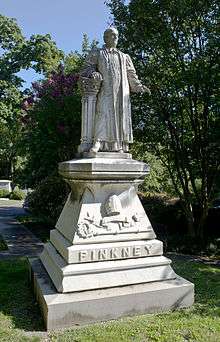William Pinkney (bishop)
William Pinkney (April 17, 1810 – July 4, 1883) was fifth bishop of the Episcopal Diocese of Maryland.
The Right Reverend William Pinkney D.D., LL.D. | |
|---|---|
| Bishop of Maryland | |
.jpg) | |
| Church | Episcopal Church |
| Diocese | Maryland |
| In office | 1879-1883 |
| Predecessor | William Rollinson Whittingham |
| Successor | William Paret |
| Orders | |
| Ordination | May 27, 1836 by William Murray Stone |
| Consecration | October 6, 1870 by Benjamin B. Smith |
| Personal details | |
| Born | April 17, 1810 Annapolis, Maryland, United States |
| Died | July 4, 1883 (aged 73) Cockeysville, Maryland, United States |
| Buried | Oak Hill Cemetery (Washington, D.C.) |
| Nationality | American |
| Denomination | Anglican |
| Parents | Ninian Pinkney & Amelia Grason Hobbs |
| Spouse | Elizabeth Lloyd Lowndes |
| Previous post | Coadjutor Bishop of Maryland (1870-1879) |
Early life
He was born in Annapolis, Maryland and attended St. John's College, Annapolis, from which he graduated at age 17. He studied law under his uncle, Severus Pinkney, and was admitted to the bar, but never practiced. Instead, influenced by his mother, a devout Methodist, in 1831 he entered Princeton Theological Seminary in New Jersey to study for the ministry. Financial and family circumstances forced his withdrawal two years later, and Pinkney became a tutor to the family of John Neville Steele, a devout Episcopalian in Dorchester County, Maryland. He decided to apply for holy orders with that denomination.[1]
He married Miss Elizabeth Lowndes, from a prominent family in Prince George's County, on October 2, 1838.[2]
Career
Maryland's bishop, the Right Reverend William Murray Stone ordained Pinkney to the diaconate on April 12, 1835, and to the priesthood the following year. Rev. Pinkney was initially assigned to Somerset and Coventry parishes on the Eastern Shore, but his health soon failed. He then became as rector of St. Matthew's Episcopal Church in Hyattsville, Maryland (formerly known as Addison's Chapel) and its chapel of ease Zion Parish. During his leadership of those parishes, which lasted until 1857, Rev. Pinkney secured the rebuilding of both churches. St. Matthew's congregation moved to a larger Gothic-style frame building in Bladensburg, Maryland in 1844, which was consecrated in 1856. St. John's Episcopal Church, Zion Parish (which had once been the lower chapel of that parish and burned down in 1845), was rebuilt and consecrated in 1856. After getting both congregations onto solid footings and declining a call from the Church of the Epiphany (Washington, D.C.), Rev. Pinkney finally decided to move into Washington, D.C. and serve as rector of the Church of the Ascension.[3]
During the American Civil War , bishop William Rollinson Whittingham, who had convinced Rev. Pinkney to accept the Ascension position just before the war, reprimanded the southern-sympathizing priest for failing to say prayers for President Lincoln, and instituted ecclesiastical proceedings against him (which failed). Rev. Pinkney served at Ascension 13 years, and after the war ended also served as assistant to Rt.Rev. Whittingham, whose Northern sympathies had caused considerable unpopularity.[4]
Episcopate
In 1870, the Diocese of Maryland held its convention in the Church of the Epiphany in Washington, D.C. and Pinkney was elected as suffragan to the ailing Rt.Rev. Whittingham. Presiding Bishop Benjamin Bosworth Smith was his principal consecrator on October 6, 1870, assisted by bishops John Johns of Virginia and Thomas Atkinson of North Carolina. Rt.Rev. Pinkney administered the diocese during Whittingham's extended convalescence before succeeding his mentor upon his death in 1879.
Death and legacy

Bishop Pinkney died in office on July 10, 1883.[5] He is buried in Oak Hill Cemetery in Washington, with the grave sculpture financed by his friend, the financier W.W.Corcoran. The Maryland diocesan convention the following year elected William Paret his successor. A memorial church honoring his memory was built at Hyattsville (whose founder Christopher C. Hyatt he had confirmed in 1855), but later destroyed. The windows behind the altar at St. John's Episcopal Church, Zion Parish, where he had once served and whose rebuilding in brick he had secured, were also donated in his memory.
References
- Betty and Neil Hotchkiss, History of St. Matthew's Parish, Prince George's County at p. 12, available at http://www.stmatthewshyattsville.org/st_matthews_history_to_1961.pdf
- Hotchkiss at p. 12
- Hotchkiss at p. 15
- http://www.ascensionandsaintagnes.org/html/parishlife/parishhistory.htm
- https://www.findagrave.com/memorial/95735900
External links
- Works by or about William Pinkney at Internet Archive
- The Life of William Pinkney by William Pinkney
- Life of the Right Reverend William Pinkney, D.D., LL.D., Fifth Bishop of Maryland, by Orlando Hutton (1890)
| Episcopal Church (USA) titles | ||
|---|---|---|
| Preceded by William Rollinson Whittingham |
Bishop of Maryland 1879 – 1883 |
Succeeded by William Paret |